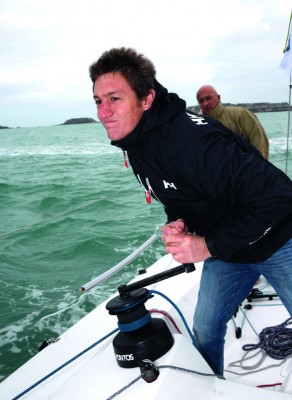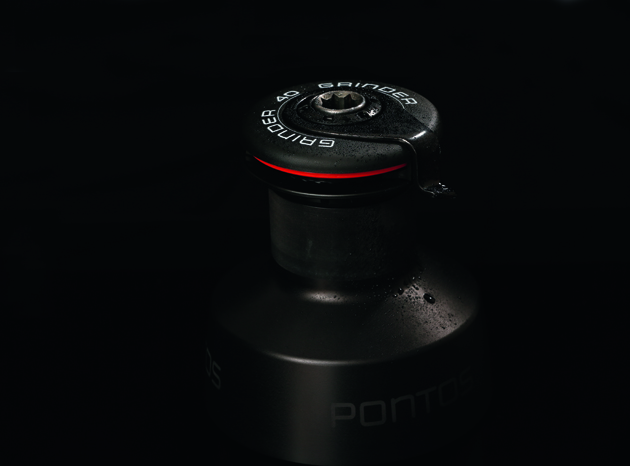It’s the biggest advance in winch design in a generation. Toby Hodges tries out two new four-speed winches from French company Pontos
Pontos four-speed winch
How frustrating it would be to have a car with just two gears! Yet most sailors still rely on standard two-speed self-tailing winches for all winching applications. The self-tailing winch came out in the 1970s but, apart from aesthetics, ease of maintenance and reversible technology, there has been little fundamental change in its design since then.
All that is about to change, however, as a new French company called Pontos introduces four-speed winches that offer potentially the biggest advance in manual winch technology in a generation.
In essence, Pontos has added a clutch to provide two extra gears, which can be used to provide either more speed or more power. So with two faster gears, the Grinder winch offers up to six times the line-speed of conventional two-speed winches. Alternatively, the Trimmer model has two higher gears, offering twice the power and reducing the force needed to winch a line.
Intrigued to find out if the theory worked on the water, I travelled to St Malo to test both types of winch on two different yachts.
I was blown away by the results.
How four-speed winches work
Pontos winches look like normal (Lewmar/Harken) self-tailing winches. They use the same quality materials and they function in much the same way. However, the French company has incorporated a clutch and a trigger mechanism to enable the seamless engagement of two extra gears. And by reversing this clutch mechanism two different models for different applications can be created.
Crucially, Pontos has used tried-and-tested mechanics. The winches use a planetary gear system – one or more outer ‘planet’ gears that revolve around a central ‘sun’ gear – and a dog clutch commonly used in manual gearboxes in cars and bicycle hub gears.
These two systems have been around for decades. The magic, the invention and the patent-protected part is the composite clutch ring or ‘trigger’ the company designed to enable the clutch to move up and down to engage the gear system.
How does this work? The crown is independent of the drum. When tension is applied and the large gear meets resistance in its springs, it moves this trigger ring enough (9mm/18º) to push up and engage the clutch. The mechanical force on the drum now works the two extra gears.
The load remains on the metal-on-metal gears as normal – “like a car, there is no load on the gearstick,” says co-founder Darryl Spurling. Changing gear simply involves changing direction with the winch handle, as with a two-speed winch.
A Pontos winch requires no more maintenance than any other modern winch. A key is supplied to open the top and the whole drum lifts off to expose the gears and bearings, which require only an infrequent freshwater rinse or lube.
The Grinder for more speed
We sailed from St Malo aboard a JPK 10.80 fitted out with Pontos 40s on the coachroof plus size 46 primaries. One tack in and I was impressed – Bang! The jib was in before I even looked up to check the trim. A couple more tacks and I was completely sold.
On a crewed racing boat one person lets off the windward sheet during the tack and another pulls in the new working sheet as quickly as possible. The beauty of the Grinder is that it allows you to set up for a tack with the lazy sheet ready in the self-tailer and the winch handle engaged.
I could easily let off one sheet during a tack and sheet in the other quicker than two could perform the operation on standard winches. There were no shouts to attend the ‘skirt’ (foot of the jib getting caught on the pulpit) and no fighting with the winch handle.
By the time I remembered to look up at the jib, it was almost too late – in light winds it is possible to over-sheet in just four turns of the handle. Yet you still have three higher gears to trim with when the breeze is up. Our skipper, Gilles, said he was especially happy with the ease and comfort the winch brought in windier conditions.
Remembering which way to turn the handle for first gear is crucial. Pontos says future winches will have an arrow indicating this. I didn’t hear the gear change every time – a small click indicates the clutch engaging. But changing direction is intuitive and familiarity comes reasonably quickly.
For short-handed sailors the benefits are obvious. Some 25 per cent of the Class 40 fleet has already adopted Pontos winches, including Sebastien Rogues, who currently tops the Class 40 leaderboard on GDF Suez.

Thibaut Vauchel-Camus using a Grinder on Solidaires en Peloton. The Class 40 finished 2nd in the Route du Rhum. Photo: Pierrick Contin
His boat captain, Martin Piquet, explained some of the benefits the Grinder winches have brought while they prepared for the Route du Rhum. GDF has two sets of size 52s in the cockpit and a size 40 at the mast base (for rapidly hoisting spinnaker halyards and socks).
The speed of the Grinders is such that a spinnaker can be gybed with the sheet in the tailer. And flying sails can be furled at twice the speed – important when trying to maintain boat speed during a sail change. By leaving a sheet in the self-tailer, the crew can tack quicker than hauling by hand, while being able to keep one hand free.
The Trimmer for more power
Unlike the Grinder, the Trimmer does not change the method by which you tack. The first two gears are the same speed as conventional two-speed winches, so a tack still involves pulling a sheet through before locking it into the self-tailer. But it is the ease with which you can then continue to wind in a heavily loaded sheet that proved astonishing with this winch.
Traditionally, this would require two hands, shoulders, your back and any other leverage you can get from a typically awkward position. However, with the Trimmer in its lowest gear, it requires a mere two-fingered effort.
Employing the extra gears of the Trimmer feels like locking a diff on a 4×4, engaging low range (4L) and ploughing up a mountain, slowly but surely. As long as you have time, the torque gets you there.
This was demonstrated to us aboard Karibario, a weathered Sun Odyssey 40. She is still raced hard by an enthusiastic, yet elderly crew. They were increasingly struggling with the effort required to sheet in the large, overlapping genoa.
Her owner, Jean Legallet, previously had Harken 44s mounted on his coachroof and explained how it needed a “100kg brute” to grind in the genoa. The fourth gear of the Pontos means it can now be done one-handed by any of his crew. Their only concern now is the danger of actually exerting too much load.

Jean Legallet and his senior crew can now winch in a large overlapping genoa easily one-handed. Photo: Graham Snook
Interestingly, Legallet tried both a Trimmer and a Grinder model aboard Karibario. It was thought that the speed of the latter would enable him to get the sheet in quickly enough for it not to be a struggle. But it was not the speed that was a problem for his crew; it was the effort required to grind in those final few feet of sheet.
The Trimmer proves so easy it takes away the need to fit an electric winch.
For me this is the most exciting thing about Pontos winches. Their advantage is not just about speed and ease when racing; it is much more about making life easier for cruising sailors.
The Trimmer allows you to winch high loads manually with ease – whether you’re winching a crewmember up the mast, hoisting or sheeting sails, or even retrieving a waterlogged man overboard.
Four-speed is the way to go
The names can be confusing, but if you focus on which type most suits your sailing, there are fundamental benefits to both. The more I look at conventional two-speed winches now, the more they seem needlessly slow, awkward and laborious.
Yes, you may replace winches only once in a lifetime and, yes, Pontos may be a slightly costlier upgrade, but if it makes your sailing safer and easier, and encourages more people afloat more often, it is something to champion.
While the speed of a Pontos Grinder is an obvious attraction to the racing market, I think the big potential lies in the ease both types of winch can bring to cruising sailors. Hunching over a winch to exert effort can be dangerous, off-putting hard work. It pushes sailors towards powered winches, which are a much costlier upgrade and can be dangerous.
Prices:
Pontos winches are 10-12 per cent more expensive than entry-level Harken or Lewmar two-speed winches. But the winches are cheaper than the Sport or Performer models by the same amount, which is perhaps a fairer comparison. And crucially, they are approximately one-third the price of an electric winch.
Size 40 – Grinder €1,320 (£1,033); Trimmer €1,380 (£1,080).
Who are Pontos?
I first came across Pontos two years ago when the company had a working prototype at the Marine Equipment Trade Show (METS). As nothing further was heard, I feared this was a novelty that had died away, hindered by expense or unreliability. It turns out that the St Malo company had really been doing its homework before officially coming to market this summer.
Start-up company specialists Michel Chenon and Darryl Spurling founded Pontos, and they have implemented an impressive R&D department and quality control process. Design and testing is done in-house, but manufacturing is outsourced to western Europe. We were shown the rigorous testing procedures and numerous cycles the winches are put through.

Among the rigorous tests, the load in the rope is measured versus the yield of the winch to calculate efficiency
The winches have been designed for the everyday sailor – the user, not the boat, the retrofit not the OEM market. The company is not trying to compete on price with Harken and Lewmar. “We wanted it [the winch] to be simple and robust,” says Spurling, “to look similar and be priced similar, but to outperform the competition.”
For Chenon, it was once they figured that they could reverse the gearing to offer both power and speed benefits that the business looked promising.
He is targeting a €10m turnover in 2015 and thinks they have a three-year head start on Harken and Lewmar.
Verdict
I travelled to St Malo thinking Pontos might be a novelty idea, but left convinced these winches could bring a major benefit to most sailors. Try four gears and it’s hard to look back.










